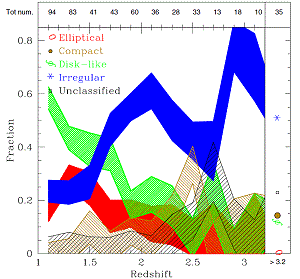- Details
- Published on 07 February 2014
Vol. 562
In section 4. Extragalactic astronomy
Listening to galaxies tuning at z ∼ 2.5–3.0: The first strikes of the Hubble fork
 When do galaxies begin to settle on the Hubble sequence? From a sample of about 500 galaxies at Redshift larger than 1, which was observed with the Hubble Space Telescope (HST) in infrared (key project CANDELS), the European team has shown that most galaxies are irregular above redshift 3. Progressively, galaxies settle in elliptical and disk galaxies of the Hubble sequence at redshift 2.5<z<3. The fractions of both ellipticals and disks decrease with and increasing lookback time at z>1. Star formation is much more active at high redshift than today, but two color sequences (blue and red) can still be distinguished with ellipticals in red and irregulars in blue. Disks are more distributed. Only 33% of all morphological ellipticals at z>1 are red and passively evolving galaxies.
When do galaxies begin to settle on the Hubble sequence? From a sample of about 500 galaxies at Redshift larger than 1, which was observed with the Hubble Space Telescope (HST) in infrared (key project CANDELS), the European team has shown that most galaxies are irregular above redshift 3. Progressively, galaxies settle in elliptical and disk galaxies of the Hubble sequence at redshift 2.5<z<3. The fractions of both ellipticals and disks decrease with and increasing lookback time at z>1. Star formation is much more active at high redshift than today, but two color sequences (blue and red) can still be distinguished with ellipticals in red and irregulars in blue. Disks are more distributed. Only 33% of all morphological ellipticals at z>1 are red and passively evolving galaxies.


